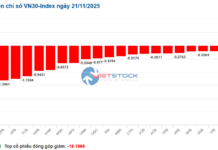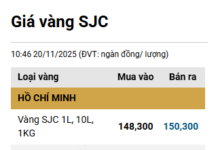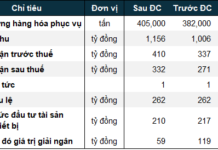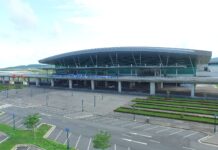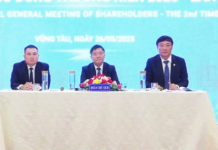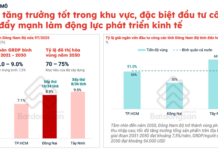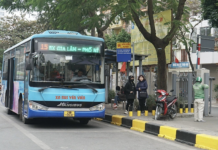“Our dream is to build a true maritime hub like Singapore or Hong Kong. Vietnam has the potential to make this a reality,” said Mr. Pham Quoc Long, Deputy General Director of Gemadept, who has nearly 40 years of experience in the industry, at the specialized session of Committee II.
Mr. Long emphasized that the current moment is ripe for achieving this goal, as geopolitical competition reshapes global supply chains, creating a rare opportunity for Vietnam. Ho Chi Minh City, along with Vung Tau and Binh Duong, has formed a megacity of 18 million people, contributing nearly 25% of the country’s GDP and handling approximately 30 million TEU containers and nearly 800 million tons of cargo annually. However, Vietnam remains in a “logistics trade deficit” as nearly all import-export goods are transported by foreign shipping lines, causing logistics costs to account for 16-17% of GDP while contributing only 4-5% to GDP.
Sharing the same view, Mr. Pham Anh Tuan, General Director of Portcoast, stated that Vietnam has the capability to become an international maritime center. He cited that the Ho Chi Minh City and Cai Mep – Thi Vai areas alone account for over 30% of the total cargo volume through seaports nationwide, with containers making up more than 70%. Approved plans allow for a total quay length of approximately 23 km in this area, nearly equivalent to Singapore, with a maximum capacity of 50 million TEU per year.
“This highlights the feasibility and high readiness for establishing an international maritime center, as numerous favorable factors have converged,” he stressed.
Mr. Tuan identified at least six critical factors that Vietnam already has or is gradually perfecting: large-scale quays; fully equipped fairways, anchorage, and pilotage; logistics centers integrated with free trade zones; multimodal infrastructure including sea, road, rail, and inland waterways; commercial, financial, and legal services supporting the maritime industry; and a system for training, repairs, and pilotage. The missing link is the supply of fuel for ships, including oil and future clean energy, which is crucial for completing the international port ecosystem.
According to the General Director of Portcoast, for the maritime center to operate efficiently, a modern management mechanism is needed. A decade ago, Portcoast proposed a Port Authority model to replace the “port administration,” granting strong autonomy to local authorities while the central government plays a coordinating role. This international experience is worth considering for Vietnam. He also affirmed that early involvement of businesses is essential.
“When planning this area (Cai Mep – Thi Vai), we proactively engaged with maritime and logistics businesses. Their input provided a reliable basis for determining needs, scale, and planning progress, making the plan more realistic and feasible,” shared Mr. Pham Anh Tuan.
Echoing this view, Mr. Dang Vu Thanh, Vice Chairman of the Vietnam Logistics Business Association (VLA) and General Director of Sotrans, stated that an international maritime center is “the dream of the entire logistics industry” and emphasized learning from plans that are “beautiful on paper but difficult to implement” by involving businesses from the planning and pilot project stages.
Experts at the session also agreed on adopting the specialized Port Authority model, following international experience, as a valuable suggestion. To become an international maritime center, the port needs to be “open” and managed uniformly, with the authority to offer timely incentives to attract major shipping lines. Currently, ports are managed by multiple ministries and agencies, while the Ho Chi Minh City People’s Committee only coordinates generally, so specific policies like 2-3 years of tax exemption for shipping lines committing to increased volume have not been implemented.
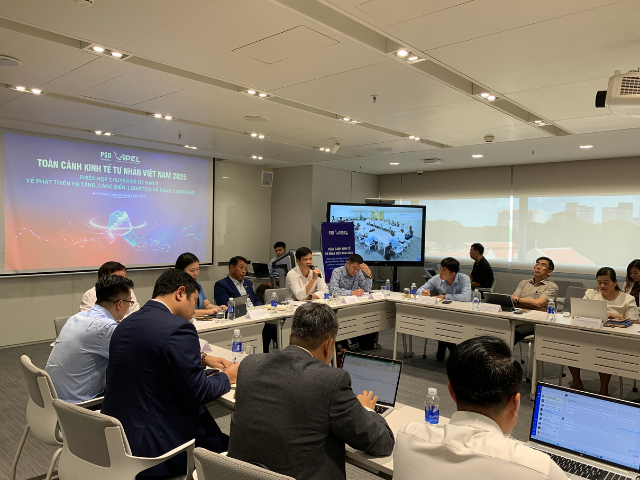
The morning session on September 29 gathered many experts in the fields of ports and logistics – Photo: Tu Kinh
|
To realize this goal, experts proposed three key solution groups.
First, comprehensive planning. Ports need to be integrated into a synchronized system with shared infrastructure, rather than being fragmented as they are now. An estimated investment of 10 billion USD over the next 5-10 years could create over 20,000 direct jobs. Simultaneously, Ho Chi Minh City should leverage its advantages from the free trade zone and emerging financial center to enhance its appeal.
Second, policy mechanisms. Vietnam needs to establish a unified port management authority with the power to offer competitive incentives like 2-3 years of tax exemption for international shipping lines. Some also suggested positioning Vietnam as a “free trade nation” to promote an open image, attract investment, and shift supply chains.
Third, technology and connectivity. Developing a Port Community System (PCS), a shared data platform for all port activities, is a top priority. “This will be the foundation for creating an open port, connecting public and private sectors, centralized management, and optimized productivity,” said Mr. Nguyen Thanh Binh, General Director of Gemadept. Additionally, inland waterway transport, currently handling only 20% of goods compared to 79% by road, needs development. A 200-300 ton barge can replace 300 trucks, saving costs and reducing pollution.
To achieve efficiency, bottlenecks in bridge clearance and waterways must be addressed. The Ha Nam Canal in Hai Phong needs widening for two-way traffic, while many bridges in the North and South are too low, restricting large barges. The government has allocated 6.48 trillion VND for inland waterway infrastructure from 2026-2030, and if key projects are implemented early, logistics costs could drop by 10%.
Some experts also emphasized investment efficiency. Mr. Tran Khanh Hoang, Vice Chairman of the Vietnam Port Association (VPA), noted that projects like Tran De Port are not yet truly necessary with volumes of only a few hundred thousand TEU per year, while Cat Lai has surpassed 5 million TEU. He recommended focusing capital on waterways, highways, and high-speed railways to enhance transport capacity.
Experts agreed: long-term planning, open mechanisms, modern technology, and strong public-private collaboration are decisive factors. With political determination, business partnership, and sufficient investment, the ambition to make Ho Chi Minh City an international maritime center is entirely achievable in the next decade.
– 11:45 03/10/2025
Proposed $10 Billion Investment for International Maritime Center in Ho Chi Minh City
Vietnam has emerged as one of the most dynamic container transport markets in the region, yet it remains a logistics trade deficit country, with most supporting services provided by foreign entities. In response, private enterprises are advocating for public-private partnerships to transform Ho Chi Minh City into a global maritime hub.

